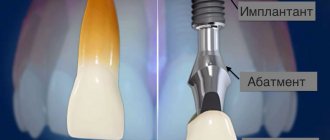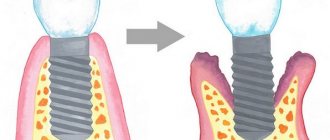12.10.2021 242
Tooth extraction is an operation that traumatizes the gums. Therefore, for some time after surgery you will undergo a rehabilitation period. It is accompanied by minor pain and the need to follow special recommendations on nutrition and oral hygiene.
But sometimes patients also notice swelling of the cheek next to the extracted tooth. Let's look at what causes this reaction, whether it is normal and when you should see a doctor.
The main causes of swelling
When a tooth is removed from the gum, an inflammatory process always occurs. It is for this reason that swelling usually appears, and with it a visible swelling of the cheek on the side of the extracted tooth.
It is important that the removal operation is performed by a dentist with extensive experience, and that the patient strictly follows the recommendations. This will prevent infection from entering the wound. When everything is in order, the inflammatory process gradually fades away on its own. At the same time, the pain decreases and the swelling also decreases.
The timing of swelling depends on many parameters:
- Individual physical characteristics of the patient.
- Removal method.
- Type of tooth removed.
- General condition of the oral cavity.
If the procedure was performed correctly, the patient has a strong immune system and there are no serious diseases, the swelling lasts up to four days. Sometimes this condition can last longer - up to one week.
Concerns begin to arise if more than 7 days have passed, and swelling is still noticeable on the cheek next to the extracted tooth. In this case, you need to contact the dentist again. He will conduct an inspection and evaluate the causes of the problem.
You shouldn’t wait for swelling to appear right away. It usually occurs after the anesthesia wears off. In this case, pain also begins to appear. To remove it, simply use the analgesics recommended by your doctor.
A special case is the removal of a wisdom tooth. In this case, the operation is more complicated and damages the gums more. Often the doctor has to apply a suture to speed up the recovery process. You should be prepared for the fact that the swelling in this case will be longer.
In addition, swelling is accompanied by fever and general weakness. During the recovery period, some patients notice difficulty swallowing and trying to articulate speech.
Sometimes after wisdom tooth removal, doctors may prescribe not only analgesics, but also some antibiotics. This allows you to prevent the development of an infectious process. But taking something without a prescription is strictly not recommended.
How do you know if swelling is normal?
After dental implantation, the cheek may swell - a situation that occurs when many implants are installed in the absence of teeth; you can read about implantation in the absence of teeth at the link. During the operation, a small tissue incision is made, a bed for the implant is formed in the bone, and the product is fixed. These manipulations are accompanied by trauma to blood vessels, nerve endings, soft tissues, and mucous membranes. After an injury, tissue healing occurs and slight swelling may occur.
Symptoms of the normal postoperative period:
- The degree of swelling will depend on the extent of the intervention: the larger the wound, the greater the swelling of the tissue.
- The tumor grows to its maximum on the second day after surgery, persists on the third day, and then decreases.
- The pain is aching and can be relieved with medications.
- After a week, the swelling disappears.
Other reasons
Everything described above can be attributed to natural causes of swelling. It occurs even if the person is healthy and the tooth is removed correctly. But there are several additional causes of swelling that are also worth keeping in mind. These include:
- Tooth extraction from a patient who has already developed a strong gumboil for some reason.
- Difficulty in removal is especially common in the case of wisdom teeth.
- Infection in soft tissues for any reason.
- Individual intolerance, allergies to medications used during surgery.
- Incorrect tooth extraction, medical error.
- Concomitant chronic diseases, such as neuralgia or hypertension.
When a patient does not follow the doctor’s recommendations regarding maintaining a proper diet and careful oral hygiene, the likelihood of a complication becoming many times higher.
What pathological process can be suspected with persistent swelling?
When performing a sinus lift by an inexperienced doctor, perforation of the maxillary sinus is possible, which is accompanied by characteristic symptoms, including swelling. Consequences of this outcome of the operation:
- inflammation of the maxillary sinus;
- penetration of bone material into the sinus;
- complicated course up to meningitis.
Since some options for bone grafting end with the implantation of an implant, there is a risk of complications associated with its rejection or the development of inflammation around it (peri-implantitis). Both of these pathological processes are associated with a violation of surgical technique and the presence of a focus of infection in the oral cavity. The problem is serious, although extremely rare.
- In the case of peri-implantitis, the inflammation is localized near the dental implant and is accompanied by all the characteristic symptoms - pain, hyperemia, severe swelling.
- Rejection of the implant occurs due to the influence of immune factors on it and depends on the individual characteristics of the patient’s immune system. In some cases, this process develops rapidly, while in other cases, rejection can be suspected by pronounced swelling that does not decrease with time, pain, and deterioration of the patient’s general condition.
If the swelling begins to bother you greatly and other alarming symptoms appear, you should seek qualified help from a doctor. Treatment of pathological processes must be timely and comprehensive .
Potential complications leading to swelling
When swelling does not go away for more than seven days, we can talk about the constant progression of inflammation. In this case, it is recognized that the patient has complications. It is very important to establish their causes and nature, and then quickly eliminate them.
There are several most common types of complications that patients usually complain about:
Alveolitis
There is always a small blood clot in the hole that remains in place of the extracted tooth. This is a natural reaction of the body aimed at preventing infection. The clot does not allow bacteria to penetrate inside - the wound gradually heals and heals.
But sometimes the clot is removed. As a result, the tissues remain defenseless, infection can occur and pus can begin to accumulate. In this case, inflammation will become more and more intense and will cover large areas.
Inflammation of bone tissue
Not the most common complication, but you won’t be able to insure against it either. It is usually characterized by the appearance of severe swelling that begins to spread throughout the jaw. In this case, the patient experiences severe pain and is practically unable to open his mouth or chew food normally.
The big danger is potential blood poisoning. Therefore, at the first signs of worsening inflammation, you should contact your doctor as soon as possible.
Gum abscess
Characterized by severe suppuration. If it is not addressed, you may lose other teeth in the row.
Flux
Also called “periostitis of the jaw” in the medical community. An intense inflammatory process, which, in addition to swelling, also manifests itself as severe pain in the jaw, radiating to the temples. The temperature rises and the patient feels very weak. Among the dangers are transition to a chronic form and the development of osteomyelitis.
Neuritis
In this case, severe damage to the facial nerve occurs. Not only the area next to the extracted tooth swells, but also the cheeks, tongue, and larynx.
How to remove at home
The instructions for the postoperative period indicate in as much detail as possible what will help reduce the size of the swelling. Please read it carefully.
Cooling compress
The bag of post-op medications contains ice in a blue bag, freeze it in the freezer and reuse. Immediately after bone grafting, it is recommended to apply an ice pack (previously wrapped in a cloth or towel) to the cheek on the side of the operation. The duration of such a compress should not exceed 10-15 minutes, after which you need to take a half-hour break. The effect of using this simple method appears almost instantly - pain subsides, swelling stops increasing.
It should be taken into account that there are contraindications to this method of eliminating swelling, for example, trigeminal neuritis. Cold compresses are recommended for the first 24-48 hours, since it is during this time period that their effectiveness and safety are highest. If you hold the ice for longer than 15 minutes, there is a risk of hypothermia, be careful with this!
Taking medications
In addition to the local effects of low temperature, do not forget about taking medications. After osteoplasty, patients are prescribed anti-inflammatory and painkillers that help reduce or eliminate swelling and cope with other unpleasant symptoms of inflammation. In addition to anti-inflammatory drugs, multivitamins and broad-spectrum antibiotics are prescribed to prevent bacterial complications. You should take medications strictly as prescribed by your doctor or as instructed, without exceeding the permissible dose.
Diet
Also during the rehabilitation period, the prevention of edema is following a proper diet, drinking regimen, complete exclusion of chewing load on the side of the operation, regular brushing of teeth and baths with an antiseptic after each meal.
Read more about the rules of the rehabilitation period here - After a sinus lift
All these measures are aimed at relieving the symptoms of inflammation and thereby reducing swelling after sinus lifting and bone grafting. Eating spicy, too hot, hard food irritates the mucous membrane of the gums and increases swelling, and failure to maintain oral hygiene and neglect to use an antiseptic increases the risk of infectious complications.
Our doctor will inform you in detail about all the nuances of the postoperative period so that tissue restoration after surgery occurs quickly and does not cause discomfort.
What to do if your cheek is swollen after removal
It is important to understand that swelling will not subside until the inflammatory process continues to spread in the tissues. You need to take the medications prescribed by the doctor.
A good option is to apply a cold compress or ice in a special bag. This is done for no more than 10 minutes, because there is a risk of hypothermia.
It is also worth following a few other simple recommendations:
- Maintain good oral hygiene and handle the area near the socket with care.
- Avoid smoking, alcohol, too hot or cold, and spicy foods.
- Do not rinse your mouth or create a vacuum in the socket area.
- Do not use folk remedies to reduce inflammation.
Remember that if you experience severe pain, fever or other signs of deterioration, you need to make an appointment with your dentist as soon as possible.
When is it necessary to contact a specialist?
We kindly ask you not to self-medicate and not to leave things to chance. Severe swelling may be a variant of the norm, your individual reaction to the intervention, but if you are unsure about something, be sure to contact your doctor. Complications are always easier to prevent than to treat.
In rare cases, swelling may occur after implantation as a symptom of complications. Occurs with reduced immunity, wound infection, and improper care. You can read more about what to do if your face is swollen after tooth implantation and what to do in the postoperative period. If you experience the following symptoms of the disease, you should visit a doctor:
- Tissue swelling, which increases from 3-4 days after surgery.
- Throbbing pain that gets worse.
- Discharge of pus.
- Unpleasant taste in the mouth.
- General symptoms include weakness, headache, malaise.
- Increased body temperature.
- Enlargement of regional lymph nodes.
What is tooth flux?
Flux, or, in dentist's language, periostitis, is a very unpleasant pathology, which is characterized by inflammation of the periosteum and soft tissues. The causes of flux on the gums can be different: trauma, gum disease, poor-quality dental treatment - all this can lead to a complication in the form of periostitis. The localization of the disease does not depend on the area of the jaw: flux of the upper and lower teeth occurs equally often.
Flux under a tooth (or above a tooth, if we are talking about the upper jaw) visually resembles an inflamed sac. However, this is far from the only possible manifestation of periostitis. There is also a serous form, when the periosteum becomes inflamed as a result of trauma and damage, as well as one of the most unpleasant types - diffuse, when the infection is localized in different parts of the jaw, which requires extensive surgical intervention with the participation of a maxillofacial surgeon.
If the gums are swollen due to periodontitis -
No less often, complaints that the gums around the tooth are swollen are associated with the patient having an inflammatory gum disease, which is called periodontitis. With periodontitis, there is destruction of the attachment of the gingival margin to the necks of the teeth, destruction of the bone tissue around the teeth, as well as periodontal fibers, due to which the tooth is attached to the bone tissue. As a result of these processes, periodontal pockets are formed between the gum and tooth (Fig. 14).
There are a lot of pathogenic bacteria in such pockets, and therefore serous-purulent exudate is always released from them. When the pocket becomes deep enough (more than 4 mm), the drainage of exudate from the gum pocket may be disrupted, which leads to the formation of a purulent abscess in the depths of the pocket. Dentists usually use the term periodontal abscess in this case (Fig. 15-16).
Swelling of the gums in the projection of the periodontal pocket –
Why gums swell during periodontitis: reasons
Periodontitis can be local and generalized. Local periodontitis differs in that it occurs only in one or several teeth exposed to a traumatic factor. For example, the formation of a periodontal pocket can be caused by trauma to the gums due to the overhanging edge of a filling in the interdental space, or by an incorrectly made crown or removable denture. Also very often the cause is traumatic occlusion, when some teeth are subjected to increased chewing load (for example, due to the loss of part of the chewing teeth).
If the teeth that have swelling on the gums do not have fillings or crowns, and you do not have long-term chronic inflammation of the gums, then you can immediately say that the reason is the presence of premature closure of the teeth in this area of the dentition. As a result, an increased mechanical load is placed on the tooth, which leads to the onset of destruction of the bone around the tooth and the formation of a periodontal pocket (24stoma.ru).
But in chronic generalized periodontitis, the causes of gum swelling are completely different. You can immediately suspect this form of periodontitis if you periodically experience bleeding when brushing your teeth, there is constant low-grade inflammation of the gingival margin in the area of all teeth (which is accompanied by swelling of the gingival papillae, their redness or cyanosis). The cause of this form of periodontitis is the accumulation of soft microbial plaque on the teeth, as well as hard dental deposits.
Microbial plaque and tartar bacteria produce toxins that destroy the dental-gingival attachment and bone tissue around the teeth, and also destroy the periodontal attachment of the tooth to the bone. With this form of periodontitis, periodontal pockets can be found in almost all teeth, and not 1-2 teeth as in the local form of periodontitis. When the discharge of serous-purulent discharge in one of the pockets is disrupted, a periodontal abscess is formed in the projection of the pocket.
Symptoms - if periodontitis, swelling of the gums occurs mainly in the projection of the apex of the tooth root or the bone interradicular septum, then with periodontitis the gums always swell in the projection of the formed periodontal pocket. Sometimes you may notice that thick pus spontaneously secretes from under the gums in the area of swelling, or it may appear when you gently press on the swelling (such symptoms clearly indicate that the cause is periodontitis, not periodontitis).
Also, the fact that the cause was local or generalized periodontitis can be indicated by the presence of mobility of the causative tooth, especially if mobility was present even before the swelling appeared. Let's now figure out what to do if the gums are swollen due to periodontitis... Treatment of the local and generalized forms of this disease will differ, because their development is caused by various reasons.
Treatment of local periodontitis –
When you see a doctor, the doctor, based on an examination and analysis of an x-ray, will determine the presence of a periodontal abscess and the amount of tissue destruction around the tooth (the depth of the periodontal pocket). Treatment immediately begins with eliminating the traumatic factor - removing the overhanging edge of the filling, grinding the contacts on the chewing surface of the causative tooth. At the same time, under anesthesia, the periodontal abscess is opened to allow the pus to drain out.
Next, the pocket is washed with antiseptics, systemic antibiotic therapy is prescribed, as well as a home course of anti-inflammatory therapy, consisting of antiseptic rinses and treatment of the gums with an anti-inflammatory gel. At the same time, the issue of the need to depulpate the tooth can be resolved, i.e. removal of the nerve and filling of the root canals (this is necessary if the depth of the periodontal pocket reaches more than 1/2 the length of the tooth root).
Removal of the nerve in such a situation is required because infection from a deep pocket can penetrate through the bloodstream into the tooth pulp (through the apexes of the roots). And then in this case, the tooth pulp itself becomes a source of infection. But this is all just basic treatment! The main treatment will be an open curettage operation of the periodontal pocket, which will remove the inflammatory granulation tissue from under the gums that has formed at the site of the destroyed bone, as well as fill the pocket with special bone material, which will partially restore the level of inert tissue.
Progress of open curettage operation –
Please note that in the first stage of the operation, the gums are peeled off from several teeth to create good access to the periodontal pocket. In the photo above you can see a deep periodontal pocket between the canine and lateral incisor (at this point all inflammatory granulations have already been cleared from the pocket). Next, the pocket is filled with bone material, which can also be covered on top with a special membrane, after which the gum is returned to its place and sutures are applied. Please note that an x-ray 5 months after the operation shows an increase in bone tissue level of about 2.5-3 mm.
In addition, if a tooth is mobile, it may be necessary to splint it with adjacent teeth using fiberglass and filling material. You can read more about these treatment methods in the articles linked below:
→ Open gum curettage operation, → Teeth splinting technique
Treatment of generalized periodontitis –
In the generalized form of periodontitis, periodontal pockets occur not in just a few teeth, but in almost all teeth. Such periodontitis usually has a chronic course with sluggish symptoms, usually manifested by bleeding and soreness of the gums when brushing, and swelling of the gingival margin. Periodically, an exacerbation of inflammation may occur, and then abscess formation may occur in the area of one or more periodontal pockets (i.e., the formation of a purulent periodontal abscess).
Treatment of the generalized form of periodontitis is very complex, and therefore a separate article is devoted to this problem on our website, which you can read at the link above. But the main stages of treatment in this case will be removal of dental plaque and anti-inflammatory therapy, after which splinting of mobile teeth and/or gum curettage can be additionally applied.










